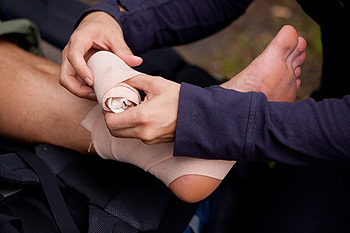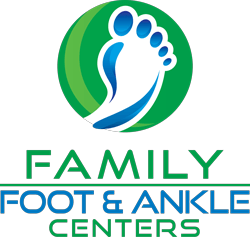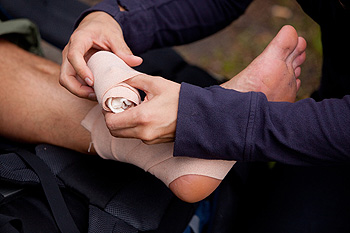What Happens During an Ankle Sprain?
 An ankle sprain, which occurs when there is a tear in the ligaments that connect the bones and stabilize the ankle, is one of the most common injuries in sports. Activities that require jumping, turning, or twisting, such as basketball, volleyball and football, increase the risk of an ankle sprain. Other risk factors include a previous ankle injury, lack of strength, stability, or flexibility in the ankle, sudden direction changes, and poor balance. Common signs of an ankle sprain include swelling, bruising, instability, and pain, particularly during weight bearing activities. Proper diagnosis of an ankle sprain requires the help of a podiatrist. X-rays will need to be taken in order to rule out a fracture, and the sprain will be assessed on a grading scale from 1-3. Upon diagnosis, rest, ice and elevation are usually suggested, and your podiatrist will provide stability options as well. If you believe that you have recently sprained your ankle, make sure to consult with a podiatrist today.
An ankle sprain, which occurs when there is a tear in the ligaments that connect the bones and stabilize the ankle, is one of the most common injuries in sports. Activities that require jumping, turning, or twisting, such as basketball, volleyball and football, increase the risk of an ankle sprain. Other risk factors include a previous ankle injury, lack of strength, stability, or flexibility in the ankle, sudden direction changes, and poor balance. Common signs of an ankle sprain include swelling, bruising, instability, and pain, particularly during weight bearing activities. Proper diagnosis of an ankle sprain requires the help of a podiatrist. X-rays will need to be taken in order to rule out a fracture, and the sprain will be assessed on a grading scale from 1-3. Upon diagnosis, rest, ice and elevation are usually suggested, and your podiatrist will provide stability options as well. If you believe that you have recently sprained your ankle, make sure to consult with a podiatrist today.
Although ankle sprains are common, they aren’t always minor injuries. If you need your ankle injury looked at, contact one of our podiatrists from Family Foot & Ankle Centers. Our doctors can provide the care you need to keep you pain-free and on your feet.
How Does an Ankle Sprain Occur?
Ankle sprains are the result of a tear in the ligaments within the ankle. These injuries may happen when you make a rapid shifting movement while your foot is planted. A less common way to sprain your ankle is when your ankle rolls inward while your foot turns outward.
What Are the Symptoms?
- Pain at the sight of the tear
- Bruising/Swelling
- Ankle area is tender to touch
- In severe cases, may hear/feel something tear
- Skin discoloration
Preventing a Sprain
- Wearing appropriate shoes for the occasion
- Stretching before exercises and sports
- Knowing your limits
Treatment of a Sprain
In many cases, the RICE method (Rest, Ice, Compression, and Elevate) is used to treat ankle sprains. However, you should see a podiatrist to see which treatment option would work best with your injury. In severe cases, surgery may be required.
It is important to ask your doctor about rehab options after you receive treatment for your injury. Stretching, strength training, and balance exercises may help the ankle heal while also preventing further injury.
If you have any questions, please feel free to contact one of our offices located in Corsicana, Ennis, and Waxahachie, TX . We offer the newest diagnostic and treatment technologies for all your foot care needs.
The information provided in this article is not meant to be medical advice and is for educational purposes only. If you would like to learn more about topics related to podiatry, feel free to contact Family Foot & Ankle Centers by clicking here or calling 972-597-4132 to reach our Waxahachie office, 903-872-9910 to reach our Corsicana office, or 972-875-3668 to reach our Ennis office.



